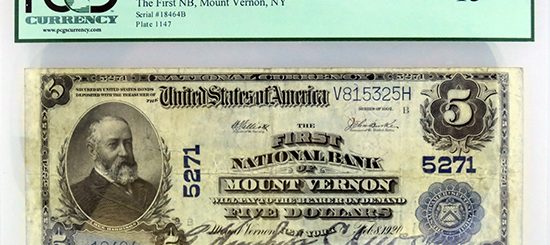Series of 1902 $5 NB of Mount Vernon NY Fr#607 F15 PCGS

The Mount Vernon First National Bank opened its doors in 1900, and like other banks of the time, issued its own currency. It printed a grand total of $5,261,000 worth of notes, which means that there weren’t many issues which would be considered rare by modern collectors. However, there are exceptions, such as this series of 1902 $5 NB.
The $5 1882 and 1902 Notes
The Mount Vernon Bank was located in Westchester County and issued currency from 1900 to 1935, which is a respectable time span for a bank of that period. It issued a total of fifteen variants, in different denominations. The number 5271 can be seen on some bills, which is the same as the bank’s charter number. The 1902 $5 note has a number of similarities with the 1882 $5 edition, namely the blue seal.
Most of the Mount Vernon Bank notes have a seal, which is either blue or brown in color. The brown seal notes tend to be more valuable among collectors as they were produced in smaller quantities. For instance, the 1882 $5 brown seal notes were issued in only about 7,550 sheets, compared to over 32,000 sheets for the 1882 $5 blue seal notes. This is a huge difference, which will dramatically influence the collection value.
The 32,000 sheets which were produced for the 1882 blue seal edition were only distributed to bank branches for a period of about ten years. These $5 notes are popular among collectors and were issued by a number of American banks. One difference between the 1882 $5 and its 1902 counterpart is that the 1882 edition has become more rare, and as such when found can be worth over a thousand dollars easily.
The $20 and $10 1882 Mount Vernon BrownAnd Blue Seal Note
The Bank of Mount Vernon also issued a total of 7,180 sheets for the 1882 $20 brown seal note. The output for the sheets is identical to that of the $10 variant. One interesting feature of these brown seal notes is that each of them has a back design which is distinct, and which is based on the state which was responsible for their issuance. Overall, the 1882 $20 brown seal notes are rare and hard to find. They were printed in smaller quantities and of all the Mount Vernon notes many did not survive to the present day.
The 1882 $10 blue seal note was issued in 21,310 sheets and were also distributed to regional banks for about a decade. It is relatively uncommon to see this large output of notes, and although the notes say 1882 their actual dates of issue were from 1908 until 1921. In other words, they are not as old as they first appear. The 1882 date which appears in cursive writing denotes the year in which the bank received its charter.


